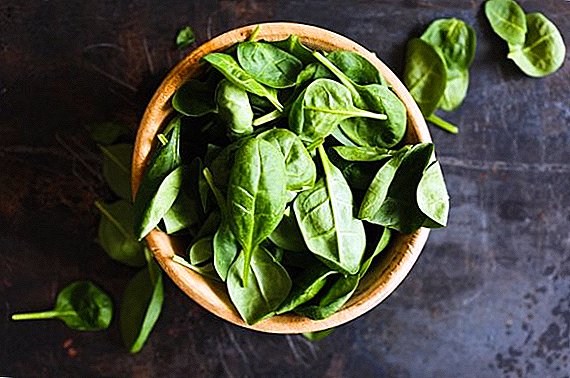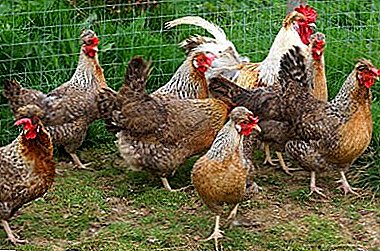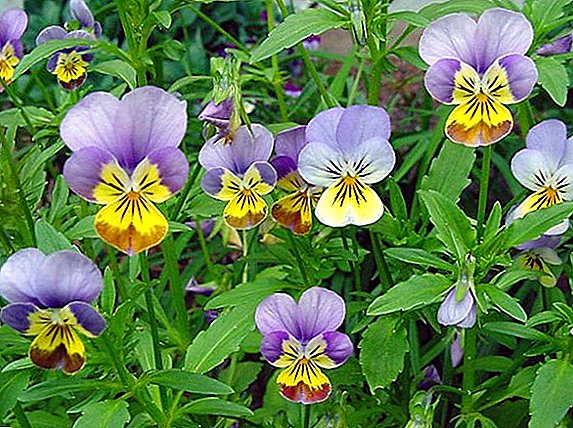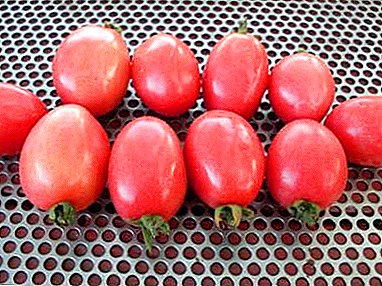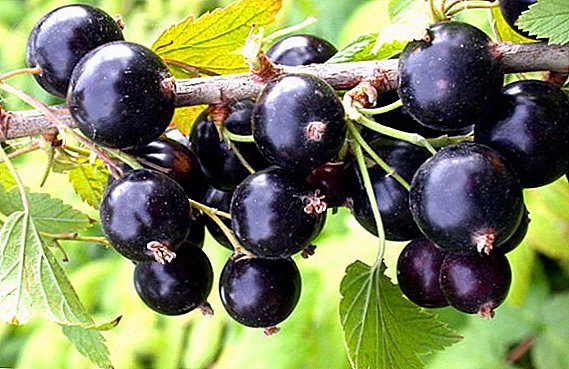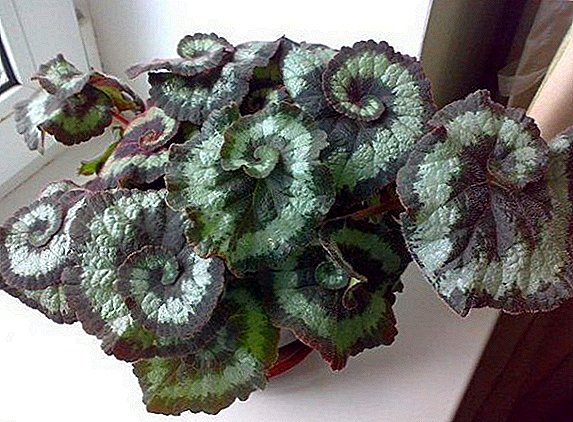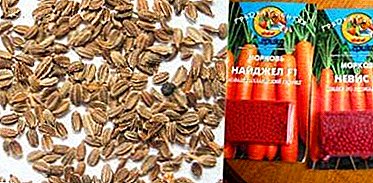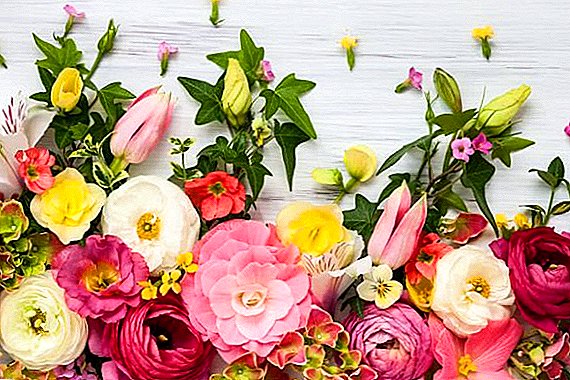 Almost every corner of our planet is filled with exotic wild or "domesticated" flowers, which differ from each other in their unique appearance, aroma and characteristic species. In this material you can get acquainted with the best of them by viewing a specially created flower collection.
Almost every corner of our planet is filled with exotic wild or "domesticated" flowers, which differ from each other in their unique appearance, aroma and characteristic species. In this material you can get acquainted with the best of them by viewing a specially created flower collection.
Aquilegia
Perennial plant of the buttercup family. Aquilegia, also known as the catchment, orlik or dove, grows predominantly in the mountainous regions of the Northern Hemisphere.  Outwardly, it is an overgrown tall shrub with delicate trifoliate, impervious to moisture, leaves. Even with heavy rainfall, water only flows down the stalk in large drops. Snow-white (blue, pink) large (up to 8 cm) flowers mostly grow one by one, and sometimes in panicles.
Outwardly, it is an overgrown tall shrub with delicate trifoliate, impervious to moisture, leaves. Even with heavy rainfall, water only flows down the stalk in large drops. Snow-white (blue, pink) large (up to 8 cm) flowers mostly grow one by one, and sometimes in panicles.
Important! By itself, this flower is not poisonous and nowadays it is often used in various landscape compositions, but tincture of its seeds can be detrimental to pregnant women. In the Middle Ages, the recipe for such a poison was used to cause a miscarriage.
Alstroemeria
Alstroemeria is a spectacular tuberous herbaceous perennial whose native land is the Chilean and Peruvian mountains.  In the wild, the stem is stretched to only 60 cm, but cultivated varieties and hybrids can be proud of a two-meter tall. The main advantage of the plant are small flowers of various shades (white, purple, pink, red, orange) with strange striped mottled on the inner surface of the petals.
In the wild, the stem is stretched to only 60 cm, but cultivated varieties and hybrids can be proud of a two-meter tall. The main advantage of the plant are small flowers of various shades (white, purple, pink, red, orange) with strange striped mottled on the inner surface of the petals.
This is interesting: The strangest flowers in the world
Begonia
Sun-begonia is a frequent inhabitant of home flower gardens. The brightness of its color palette will decorate any terrain, and a long flowering period and unpretentious care make the plant desirable for any gardener.  The compact shrub, as a rule, does not exceed 25 cm, it has green (purple) broadly oval, serrated at the edges, leaves. Small, collected in panicles, flowers can be pink to red, purple and orange. The geography of settlement is wide: Africa, America (South) and the tropics of Asia.
The compact shrub, as a rule, does not exceed 25 cm, it has green (purple) broadly oval, serrated at the edges, leaves. Small, collected in panicles, flowers can be pink to red, purple and orange. The geography of settlement is wide: Africa, America (South) and the tropics of Asia.
Read also about the cultivation and types of begonias: Bolivian, coral, tuberous, royal.
Bromelia
Tall, extended to the sun, the flower (family of Bromeliads) comes from the American tropics.  A spike (or funnel) of bright stretching inflorescence crowns the peduncle. Flowers are replaced by rather large berries, including spliced stems. Large light green leaves grow linearly, opening at the top of the tight spikelets of rich yellow or bright red flowers.
A spike (or funnel) of bright stretching inflorescence crowns the peduncle. Flowers are replaced by rather large berries, including spliced stems. Large light green leaves grow linearly, opening at the top of the tight spikelets of rich yellow or bright red flowers.
Bromeliad can be grown at home as an indoor flower.
Veronica
Veronica is interesting for its uncomplicated. Its relatively small sky blue or intense sapphire flowers are able to decorate any flower bed. The culture belongs to the Podorozhnikov family and is characterized by spikelike or umbrella-shaped inflorescences of very small flowers with a pair of stamens and thick, short, branched roots.
The culture belongs to the Podorozhnikov family and is characterized by spikelike or umbrella-shaped inflorescences of very small flowers with a pair of stamens and thick, short, branched roots.
Important! Some species of Veronica perform not only a decorative function, but are also distinguished by rich honey plants and a useful medicinal component.
Dahlia
Dahlias (the Astrov family) came from Mexico. Easily recognizable by feathery leaves, upright stalks and gorgeous variety of colors: there are more than 15 thousand varieties of dahlias.  There are dwarf in height only 30 cm, and others grow 4 times higher. They also differ in size and shape of buds: up to 10 cm in diameter (the smallest), from 10 to 25 cm (small, medium and large), more than 25 cm (these are giants).
There are dwarf in height only 30 cm, and others grow 4 times higher. They also differ in size and shape of buds: up to 10 cm in diameter (the smallest), from 10 to 25 cm (small, medium and large), more than 25 cm (these are giants).  Forms: spherical, peony, animine, collar, cactus and terry.
Forms: spherical, peony, animine, collar, cactus and terry.
Learn more about dahlias: grading varieties; varieties and cultivation of annual dahlias, planting and caring for perennial dahlias; landing dahlia spring, winter storage.
Hyacinth
The flower got its name in honor of the mythical youth Hyacinth, wounded by the wind god Zephyr. From spilled blood and grew amazingly beautiful flower. It is known that it was brought back to European countries from the Mediterranean in the 18th century, and a little later its varieties were found in Asian countries. Hyacinth belongs to the Asparagaceae family, its stem and peduncle are short and massive, the foliage is elongated, fleshy and linear. The bud (funnel or bell) deserves attention - a tall pedicel strewn with paniculate flowers, iridescent with a huge number of shades of the solar spectrum.
Hyacinth belongs to the Asparagaceae family, its stem and peduncle are short and massive, the foliage is elongated, fleshy and linear. The bud (funnel or bell) deserves attention - a tall pedicel strewn with paniculate flowers, iridescent with a huge number of shades of the solar spectrum.
Learn how to grow hyacinth at the dacha and in a pot.
Hydrangea
This delicate flower grows in shrub (up to 3 m in height) and vine forms, mainly in Indonesia, China, Korea and Japan, and is found on the American continent (about 80 species are known in total). Among gardeners around the world is very popular.  The color scheme is striking in its diversity: the hydrangea is white and cream, pink and dark purple, blue and red. Inflorescences have the shape of a ball, umbrella or panicle.
The color scheme is striking in its diversity: the hydrangea is white and cream, pink and dark purple, blue and red. Inflorescences have the shape of a ball, umbrella or panicle.  The fruit is a box with small seeds divided into 2-5 chambers. For its name, the flower could thank Princess Hortense - sister of the Roman Empire Carl Heinrich Nassau.
The fruit is a box with small seeds divided into 2-5 chambers. For its name, the flower could thank Princess Hortense - sister of the Roman Empire Carl Heinrich Nassau.
Learn more about hydrangeas: planting and care, common types: petiolate, large-leaved, paniculate, arboreal.
Dicentra magnificent
It has the concomitant touching name "broken heart", attracts worldwide attention, above all, with pink opened hearts of buds. Its homeland is the northern region of Eastern China and the Korean Peninsula. The height of the shrub is up to 1 m. The flowers are large, up to 3 cm in diameter, with long broad stamens, the leaves are openwork, bluish-green shade. 
Read also about the types and varieties of Dicterra, care for the "weeping heart" in the garden.
Kadupul
An exotic kadupul is extremely rare, it is impossible to acquire it, no matter how financially a person has. The flower is hidden in the wild state of Sri Lanka and has a serious spiritual significance in Buddhist culture.  A rare plant is considered to be cactus, characterized by a very thin, bird-like, snow-white petals and an oddly incomprehensible scent that can be clearly heard during the peak flowering period. The main feature of the cadupule is its transient flowering, starting at 11 o'clock in the evening and fully completed by midnight. After cutting the flower is able to live only a few hours.
A rare plant is considered to be cactus, characterized by a very thin, bird-like, snow-white petals and an oddly incomprehensible scent that can be clearly heard during the peak flowering period. The main feature of the cadupule is its transient flowering, starting at 11 o'clock in the evening and fully completed by midnight. After cutting the flower is able to live only a few hours.
Did you know? In the world there are many cases of using flowers in cooking as the main or additional ingredients. For example, the British and French alfalfa crumble buds in a salad, and calendula leaves act as a dressing soup. In Mexico, dahlia tubers are prepared and eaten, in China, lotus bulbs are made into flour, and in Japan, exquisite delicacies are decorated with chrysanthemum petals. In our area, people are happy to add young dandelion leaves to salads, and replace the spinach with boiled rhizomes of the plant.
Canna
Cannes has about 50 varieties, differing from each other in various shades. The main distribution - Central and South America. The unusual appearance of the plant fascinates with exotic buds that look like large ears, besides painted with bright yellow or saturated burgundy color. The leaves "look" at each other on short cuttings. In the South American countries, tubers of cannas that taste like potatoes are eaten.
The unusual appearance of the plant fascinates with exotic buds that look like large ears, besides painted with bright yellow or saturated burgundy color. The leaves "look" at each other on short cuttings. In the South American countries, tubers of cannas that taste like potatoes are eaten.
Calla
Calla is a flower of the Aroid family from South Africa. The upright long stem has a strong root in the shape of a tuber, and in the aerial part (bottom) there are oblong wide leaves.  Delicate satin buds are the main value of this flower. Curious bracts, which are sometimes referred to as bedspreads for their ability to fold into funnels and decorate the cob of small buds. The color of calla flowers is not only white, there are yellow, purple and red buds.
Delicate satin buds are the main value of this flower. Curious bracts, which are sometimes referred to as bedspreads for their ability to fold into funnels and decorate the cob of small buds. The color of calla flowers is not only white, there are yellow, purple and red buds.
We advise you to read about the types and varieties of callas, flower cultivation (at home, in the open field, diseases and pests of the flower).
Crocus
The first name comes from the Greek word kroke - "thread", the second, saffron - from the Arabic "Zeferan" ("yellow"). Crocus stigmas really look like threads, after drying, they are used both as an exquisite spice and as a strong dye.  Two dozen species of crocus are included in the family of Corridants. The stones of the Caucasus, Crimea, Central Asia and the Mediterranean took crocus from India in ancient times. These flowers are absent aboveground stem. Inflorescences rather large, directed upwards. The goblet and funnel-shaped buds have six petals each, coming directly from the corm.
Two dozen species of crocus are included in the family of Corridants. The stones of the Caucasus, Crimea, Central Asia and the Mediterranean took crocus from India in ancient times. These flowers are absent aboveground stem. Inflorescences rather large, directed upwards. The goblet and funnel-shaped buds have six petals each, coming directly from the corm.  Blossoming stars or cups of flowers have a variety of fun colors: pink, lilac, orange, yellow and white.
Blossoming stars or cups of flowers have a variety of fun colors: pink, lilac, orange, yellow and white.
Learn more about crocuses: common types of crocuses, growing at home and in the open field.
Lavender
To the family of Lambskin carry an evergreen dwarf shrub. The birthplace of the flower is considered the Mediterranean.  In the world there are about 25 species, significantly differing from each other in their growth (from 25 cm to 2 m). The image familiar to all is a lavender of spherical shape with numerous branches, a taproot and tetrahedral flowers with a pointed internode.
In the world there are about 25 species, significantly differing from each other in their growth (from 25 cm to 2 m). The image familiar to all is a lavender of spherical shape with numerous branches, a taproot and tetrahedral flowers with a pointed internode.  Shades of inflorescences: from snow-white to pale blue, purple or violet.
Shades of inflorescences: from snow-white to pale blue, purple or violet.
Lavender and lavender essential oil are widely used in traditional medicine and cosmetology. Learn how to grow a healthy flower at home and in the garden.
Lily of the valley
The grassy lily of the valley is scientifically called Convallaria majalis. Soft stalks retain resistance only until completion of flowering, and then die off. Beautiful inflorescences in the form of bluebells are plentifully scattered on the green stem (from 6 to 20 pieces) and delight the foresters (and not only them) with their white and pink delicate color. Distributed spring plant throughout Russia, as well as in temperate zones of Eurasia, North America and the Caucasus.
Beautiful inflorescences in the form of bluebells are plentifully scattered on the green stem (from 6 to 20 pieces) and delight the foresters (and not only them) with their white and pink delicate color. Distributed spring plant throughout Russia, as well as in temperate zones of Eurasia, North America and the Caucasus.
Read also about the healing properties and the cultivation of lilies of the valley in the garden.
Lantana
Lantana is an evergreen shrub with numerous flowers gathered in inflorescences, the color of which varies depending on the degree of their maturation: there is a smooth transition from yellow to pink, from pink to purple, and also from red to orange.  Widely distributed in the countries of South and Central America (especially in Colombia and Venezuela). Considered by many an ordinary weed, lantana is extraordinarily beautiful. Shrub grows up to one and a half meters. Its foliage contains medicinal essential oils.
Widely distributed in the countries of South and Central America (especially in Colombia and Venezuela). Considered by many an ordinary weed, lantana is extraordinarily beautiful. Shrub grows up to one and a half meters. Its foliage contains medicinal essential oils.
Lotus
The herbaceous perennial of the Lotus family grows mainly in Asia and Africa. The surface of the petals and leaves of a large water lily zavoskovanny, do not gain moisture and do not sink.  There are still underwater and standing leaves. White, yellow, cream, pink flowers, held on a powerful rhizome, grow to 30 cm (diameter). The blooming, open bud of the lotus always looks at the sun. Because of this, and also because the lotus is successfully used by the people as a medicinal and culinary remedy, he has earned the fame of a sacred plant in a number of traditional cultures.
There are still underwater and standing leaves. White, yellow, cream, pink flowers, held on a powerful rhizome, grow to 30 cm (diameter). The blooming, open bud of the lotus always looks at the sun. Because of this, and also because the lotus is successfully used by the people as a medicinal and culinary remedy, he has earned the fame of a sacred plant in a number of traditional cultures.
Did you know? The religious values of the lotus are many-sided: life, rebirth, purity, oblivion, peace, fertility, the interaction of male and female principles.
Magnolia
Unlike other listed flower species, magnolia blossoms are not located on the stems, but on evergreen, ancient (by the standards of scientists), a beautiful tree or a very large shrub. The southern states of the USA, where they exist in large quantities, are considered the birthplace of magnolias.  The appearance parameters of a tall (15-18 m) flower tree are beautiful:
The appearance parameters of a tall (15-18 m) flower tree are beautiful:
- evergreen, oval foliage, with specimens up to 17 cm, and fleecy to the touch on the reverse side;
- white or pink flowers with a strong, fragrant scent.
Learn more about magnolia: varieties (magnolia Sulanja), garden cultivation, vegetative and seed propagation.
Dendrobium orchid
This orchid is significantly different from other plants of the Orchid family - in shape and color of flowers, growth, and structural features. Most often it grows up to half a meter, there are also individual specimens twice as high.  Cylindrical stem with alternately arranged leaves, peduncles growing from the sinuses, containing from 1 to 4 flowers. Buds are one-color, two-color, and even three-color, and can be revealed in a variety of shades: pink, yellow, orange, white, lilac. Orchid is growing in India, Sri Lanka, Southern Japan, the Polynesian Islands and Eastern Australia.
Cylindrical stem with alternately arranged leaves, peduncles growing from the sinuses, containing from 1 to 4 flowers. Buds are one-color, two-color, and even three-color, and can be revealed in a variety of shades: pink, yellow, orange, white, lilac. Orchid is growing in India, Sri Lanka, Southern Japan, the Polynesian Islands and Eastern Australia.
We advise you to read about the popular types and care of the dendrobium.
Shenzhen Nongke Orchid
This orchid was named after its breeders. For one flower, his fans are willing to pay from 170 to 200 thousand euros. This is due both to the rarity of the orchid and the history of its creation, and the complexity of its cultivation and exotic ways. It is also interesting in the intervals between flowering - every 4-5 years.
Black petunia
Unusual petunia brought the British in 2010. This is an elegant strong plant with strong, growing up stems.  The dense bush is covered with velvet black flowers, creating a certain mystical atmosphere in any garden design.
The dense bush is covered with velvet black flowers, creating a certain mystical atmosphere in any garden design.
We recommend reading about the varieties, cultivation and reproduction of petunias.
Hairy rudbeckia
This unique Germans call the "sun hat", the Americans - "black-eyed Suzanne", the Ukrainians - "ox-eye".  The main decoration of the flower is a 15-centimeter basket of lush inflorescence, which can be colored yellow and orange, brown and black. It blooms all summer months and September. Large bright flowers are very solemn in any garden composition.
The main decoration of the flower is a 15-centimeter basket of lush inflorescence, which can be colored yellow and orange, brown and black. It blooms all summer months and September. Large bright flowers are very solemn in any garden composition.
Read also about the main types of rudbeckia and especially the care of the "sunny" flower.
Strelitzia
There are few such flowers of South African origin in nature - only five species. The pioneers of the flower were the British in the second half of the 18th century, who gave him the maiden name of the wife of King George III of Charlotte, nee von Strelitz.  At home, the plant is known as the "flower-crane", in other countries - as a "bird of paradise": because of unusual inflorescences resembling the heads of small birds with bright tufts - white-blue, fiery orange or rich yellow. The stalk at strelitzii is absent, large (40 cm) ovals of leaves (in the form of rosettes) grow directly from the root. The stem replacing the stem is high and strong.
At home, the plant is known as the "flower-crane", in other countries - as a "bird of paradise": because of unusual inflorescences resembling the heads of small birds with bright tufts - white-blue, fiery orange or rich yellow. The stalk at strelitzii is absent, large (40 cm) ovals of leaves (in the form of rosettes) grow directly from the root. The stem replacing the stem is high and strong.
Learn how to grow Strelitzia at home (from seeds).
Cymbidium red
It is an evergreen plant that lives in the wild in the north of Australia and in the Asian subtropics, from the Orchid family. Orchid usually grows on trees, sometimes on the ground or stones. Competently domesticated cymbidium reaches a height of 70 cm, blooms in winter and retains its peduncle for many months.  Outwardly exotic and elegant, like all types of orchids: linear leaves of bright green color are completed with a blunt or rounded edge. Leathery foliage with a smooth surface in length is 30-90 cm. A thin peduncle is pulled from the center of the leaf rosette, which is framed on top by a loose brush, dotted with a large number of wax red flowers (from 10 to 30).
Outwardly exotic and elegant, like all types of orchids: linear leaves of bright green color are completed with a blunt or rounded edge. Leathery foliage with a smooth surface in length is 30-90 cm. A thin peduncle is pulled from the center of the leaf rosette, which is framed on top by a loose brush, dotted with a large number of wax red flowers (from 10 to 30).
Did you know? The oldest flower cultivated in the world - the rose - grows in Germany at the Cathedral of Hildesheim and has been blooming annually for more than 1000 years, having become equal in height to almost the roof of the cathedral.
As you know, the concept of beauty is subjective, therefore, general arguments about it can cause conflicting feelings in different people. But to understand the aesthetic originality of each flower can only be compared with others, which we tried to offer you.


